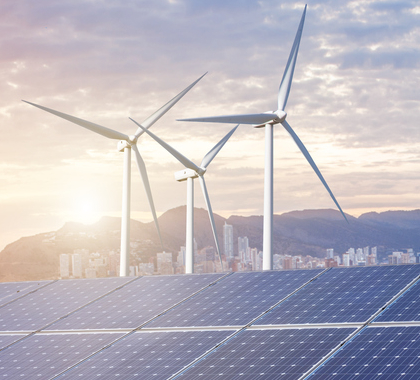A new report from the Mackinac Center for Public Policy details how “net zero” plans are threatening energy reliability for seven states in the Great Lakes region—Illinois, Indiana, Michigan, Minnesota, Ohio, Pennsylvania, and Wisconsin.
“Net zero” refers to the balance between the amount of greenhouse gases emitted into the atmosphere and the amount removed from it. Achieving net zero means that any emissions produced are offset by an equivalent amount of emissions being captured or reduced, leading to no net increase in atmospheric greenhouse gases.
Utilities are trying to achieve “net zero” by transitioning away from reliable, dispatchable power sources like coal and natural gas, to unreliable non-dispatchable “green” power sources such as wind and solar. “Dispatchable” power sources are those that can adjust to the electric grid on demand, such as a natural gas turbine, a coal plant, a hydroelectric dam, or a nuclear plant. Non-dispatchable power sources, such as solar and wind, cannot be turned on or off in order to meet demand and are highly intermittent, meaning they are not continually available 24 hours a day because of factors that cannot be controlled (like cloud cover, daylight, wind speed, air density, etc.) and are therefore unreliable.
While replacing a megawatt of electricity generation from, say, a coal plant with a megawatt of generation from a wind or solar source may appear to be an apple-to-apple swap, that is not the case. This is due to capacity factor, the measure of how often a power plant runs for a specific period of time, expressed as a percentage and calculated by dividing the actual unit of electricity output by the maximum possible output.
According to the U.S. Energy Information Administration, solar had a capacity factor of just 22 percent in 2023, while wind’s capacity factor was just 33 percent. Comparatively, the capacity factor for nuclear was 93 percent in 2023, while natural gas had a capacity factor of 58 percent, and coal 42 percent. So, a megawatt-to-megawatt swap from a dispatchable power source to these non-dispatchable sources results in a decrease in overall capacity. As more dispatchable sources of the grid are swapped for non-dispatchable sources, the less reliable the grid becomes.
As the report states, because of their unreliability and capacity factors, “wind and solar cannot be relied on as a one-for-one replacement of existing generation sources, like coal, natural gas and nuclear. If the grid relies on forms of generation that are uncontrollable and unreliable, it must also maintain backup sources that are controllable and reliable. Because wind and solar production can fall to near zero at times, utilities may need to maintain up to another grid’s worth of generation capacity.”
Public utilities are incentivized to transition to wind and solar sources through massive federal and state subsidies and are also essentially forced into the transition through state law.
Michigan utilities, for example, must have a 100 percent “clean energy portfolio” by 2040. Minnesota utilities must generate 55 percent of their electricity from solar, wind, biomass, hydroelectric, or hydrogen sources by 2035. Illinois’ municipal coal and natural gas plants must reach zero emissions by 2045 or close, and the Land of Lincoln has a renewable energy mandate requiring 50 percent of all electricity generation must come from wind and solar by 2040.
Further, many public utilities have already pledged themselves to “net zero” even without government mandate. According to the report, 32 of the 38 major investor-owned utilities in the Great Lakes region are pledged to “net zero” by 2050 or sooner.
Because of this, the report predicts energy shortfalls by 2027, “and ever larger deficits by 2032 and 2042,” for all of the Great Lakes states outside of Pennsylvania.
“This so-called energy transition — moving from reliable forms of generation to intermittent ones — is poorly planned,” the report notes. “The singular focus on reducing carbon emissions threatens to destabilize the electric grid in an unprecedented way. Building weather-dependent wind and solar generation is a hollow addition to the grid that will cause more problems than it addresses. These energy sources cannot be used as replacements for traditional generation without significant overbuilding of wind and solar and maintaining an entire fleet of reliable, backup generation, such as natural gas. The collective efforts of state officials and utilities all across the country are threatening to short the nation’s electric grids.”
“A mandated transition to renewable energy cannot be allowed to sacrifice grid stability and reliability. Policymakers must balance environmental goals with basic energy needs,” the report concludes. “They must ensure our grid remains robust and capable of meeting demand under all conditions….Policymakers should reevaluate incentive structures for utilities, promoting investments that enhance reliability and efficiency rather than merely expanding capacity.”
One way legislators can protect their constituents from the threat of an unreliable and intermittent electric grid by passing the Electricity Trajectory Management Act (ETMA), which would require the halting of any planned decommissioning of an existing dispatchable power facility if the purpose of decommissioning that facility is to replace it with a non-dispatchable power source.
Heartland Impact can send an expert to your state to testify or brief your caucus; host an event in your state; or send you further information on a topic. Please don’t hesitate to contact us if we can be of assistance! If you have any questions or comments, contact Cameron Sholty, at csholty@heartlandimpact.org or 312/377-4000.


